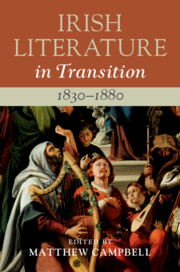Book contents
- Irish Literature in Transition, 1830–1880
- Irish Literature in Transition
- Irish Literature in Transition, 1830–1880
- Copyright page
- Contents
- Contributors
- Series Preface
- General Acknowledgements
- Acknowledgements
- Part I Contexts and Contents: Politics and Periodicals
- Part II Ireland and the Liberal Arts and Sciences
- Part III From the Four Nations to the Globalising Irish
- Part IV The Languages of Literature
- Chapter 12 Antiquarians and Authentics: Survival and Revival in Gaelic Writing
- Chapter 13 Poetry and Its Audiences: Club, Street, Ballad
- Chapter 14 Realism, Allegory, Gothic: The Irish Victorian Novel
- Chapter 15 The Rise of the Woman Writer
- Chapter 16 Dion Boucicault and the Globalised Irish Stage
- Chapter 17 Popular Prints
- Index
Chapter 13 - Poetry and Its Audiences: Club, Street, Ballad
from Part IV - The Languages of Literature
Published online by Cambridge University Press: 29 February 2020
- Irish Literature in Transition, 1830–1880
- Irish Literature in Transition
- Irish Literature in Transition, 1830–1880
- Copyright page
- Contents
- Contributors
- Series Preface
- General Acknowledgements
- Acknowledgements
- Part I Contexts and Contents: Politics and Periodicals
- Part II Ireland and the Liberal Arts and Sciences
- Part III From the Four Nations to the Globalising Irish
- Part IV The Languages of Literature
- Chapter 12 Antiquarians and Authentics: Survival and Revival in Gaelic Writing
- Chapter 13 Poetry and Its Audiences: Club, Street, Ballad
- Chapter 14 Realism, Allegory, Gothic: The Irish Victorian Novel
- Chapter 15 The Rise of the Woman Writer
- Chapter 16 Dion Boucicault and the Globalised Irish Stage
- Chapter 17 Popular Prints
- Index
Summary
Nineteenth-century Irish poetry, particularly ballad poetry, was often performed indoors and out as recitation or song. Audiences and readers varied and publications ranged from cheap broadsheets to expensive journals, edited collections or slim volumes published by Irish, English or Scottish publishers. Following the example of Moore’s popular Irish Melodies, theme, rhythm and verse-form, celebratory or nostalgic, could be shaped by older poems in Irish or by traditional tunes, many of them collected and published, and adapted to express differing personal, political and religious sentiments. Poets responsive to classical models, European Romanticism and English poets such as Tennyson could incorporate ballad forms and traditional and popular themes into a more ambitious poetics, aiming at a wider audience. Young Ireland balladists and generous-spirited journal and anthology editors, Catholic and Protestant, sensitive to sectarian and poetic diversity and different audiences, attempted to bring their readers together in a shared national culture.
- Type
- Chapter
- Information
- Irish Literature in Transition, 1830–1880 , pp. 218 - 237Publisher: Cambridge University PressPrint publication year: 2020
- 2
- Cited by

